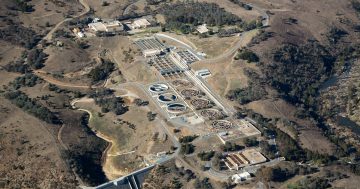
The Cotter Dam close to overflowing Thursday (1 October). Photo: Lucy Cassella, Icon Water.
The Cotter Dam is ready to overflow for the first time since 2016, while recent rains and the declaration of a La Niña event by the Bureau of Meteorology mean the ACT’s four dams could reach capacity by the end of the year.
While some people in regional areas are far from convinced the drought has broken, Canberra’s water supplier Icon Water says the ACT’s four dams could reach capacity by Christmas.
Icon Water’s general manager of infrastructure services Gerard Brierley said their modelling of current forecasts for spring indicate it is very likely that overall dam levels will reach at least 90 per cent by December.
“While it is less likely that combined storages will reach 100 per cent, it is a possibility,” Mr Brierley told Region Media.
Canberra’s combined dam levels are at 85.77 per cent, which is equivalent to 238.30 gigalitres of water. The last time the ACT’s total water storage was at 100 per cent was in November 2016.
Canberra and Queanbeyan’s total potable water demand is approximately 50 GL/year.
Levels dropped below 45 per cent in February this year following a very hot summer, record temperatures and two of the driest years on record. With above-average rainfall during winter, Canberra’s water levels recovered significantly.
Mr Brierley said Cotter Dam is likely to reach 100 per cent and begin to spill in the coming week, with current levels at 99.1 per cent and increasing by approximately 0.2 per cent daily.
“The water that spills from Cotter Dam will make its way through the Cotter River system contributing to increased flows which are particularly important for endangered Macquarie Perch to feed, breed, migrate and spawn.
“The last time Cotter Dam was at 100 per cent was in January 2018,” he said.
Googong Dam is currently at 84.29 per cent and was last at 100 per cent in December 2016. Corin Dam levels are at 72.34 per cent and were previously at capacity in November 2016.
Bendora Dam filled to capacity of 11,400 million litres and then spilled for several days in late August/early September this year due to high inflows from recent rainfall. The water spilled into the Cotter River and made its way downstream to the Cotter Dam. This along with inflows has contributed to Cotter Dam nearing 100 per cent.
Watch Bendora Dam begin to spill for the first time since 2016.
Following some heavy rainfall, the Bendora Dam is now officially full! Holding 11,400 million litres of water the dam has just started to spill for the first time since 2016. The excess water spilling over the top of the dam will be captured in the Cotter River and will make its way downstream to top up the Cotter Dam. We’re excited that the winter rain has seen an improvement in Canberra’s dam levels, but it's important that we continue to work together and use water wisely, so we’re ready for another hot and dry summer in the ACT. #careforwater
Posted by Icon Water on Thursday, September 3, 2020
Mr Brierley said while they were excited to see dam levels increase across Canberra and Queanbeyan’s four water supply dams, it was important the community remains focussed on maintaining its water-wise habits.
“Our team of analysts model literally thousands of potential scenarios to ensure we have the ability to meet the needs of our current and future population,” he said.
“Weather has the greatest influence on our water storage position, with consumption also a contributing factor. Icon Water is continually considering short and medium-term forecasts from the Bureau of Meteorology, which declared this week that a La Niña event is officially underway which makes increased rainfall over spring a high probability.”
The Bureau has confirmed that #LaNiña has formed in the tropical Pacific, with climate models suggesting it's likely to remain until at least the end of 2020.
Read more in our Climate Driver Update: https://t.co/MKYnElWVUW #ENSO pic.twitter.com/qoNz3yP1yg
— Bureau of Meteorology, Australia (@BOM_au) September 29, 2020
The consumption of water by Canberrans has also decreased compared to this time last year. Throughout September, average daily use was 123 megalitres. For the same period in 2019, it was 135.3 megalitres per day.
However, Mr Brierley said the decrease in demand is generally anticipated with cooler and wetter weather and Canberrans should maintain the permanent water conservation measures that have been in place since 2010.
“There are additional measures that commence in spring each year that are specific to when you can and can’t use sprinklers,” Mr Brierley said.
“From 1 September, only a handheld hose fitted with a trigger nozzle can be used during the hours of 9:00 am to 6:00 pm. Outside of these hours, a sprinkler or irrigation system can be used. It is a timely reminder as the community starts preparing their gardens and setting up their automatic sprinkler systems.”
Full details of the permanent water conservation measures, as well as helpful tips for households and businesses, are available on the Icon Water website.















